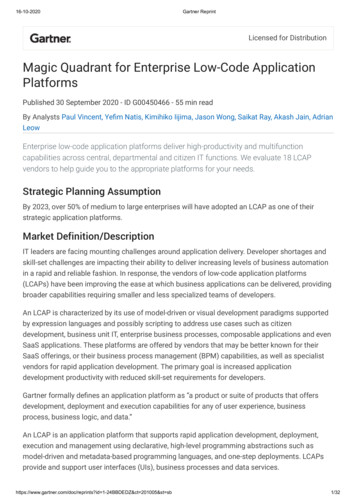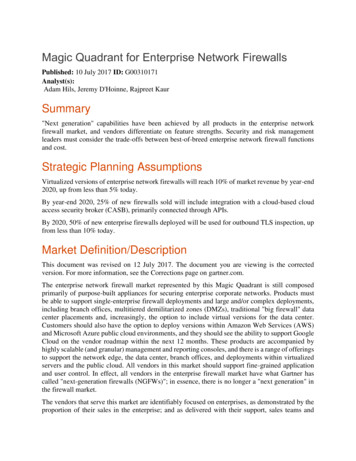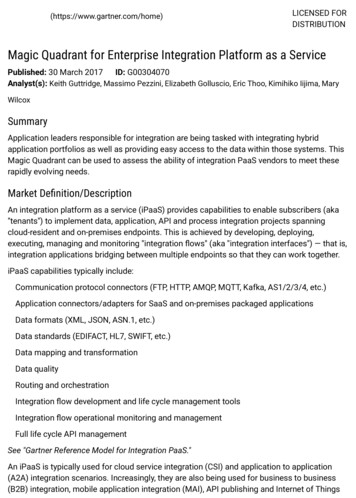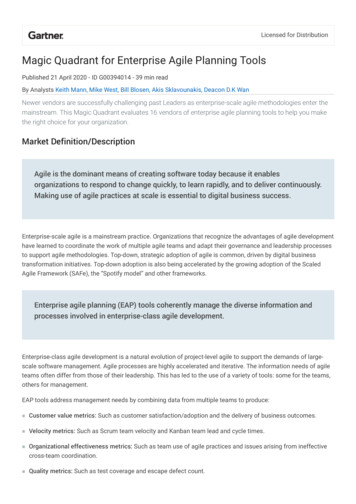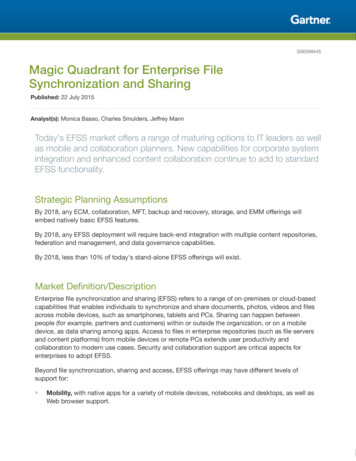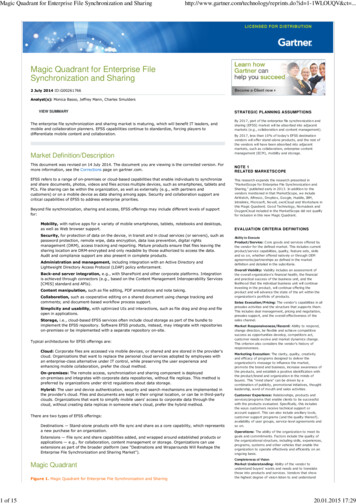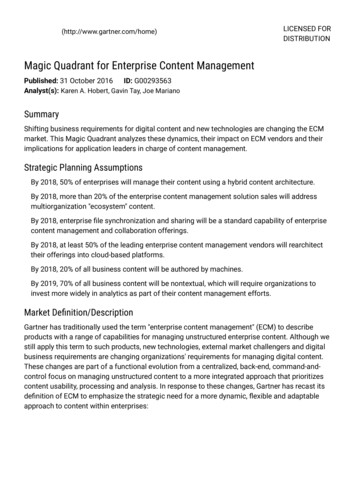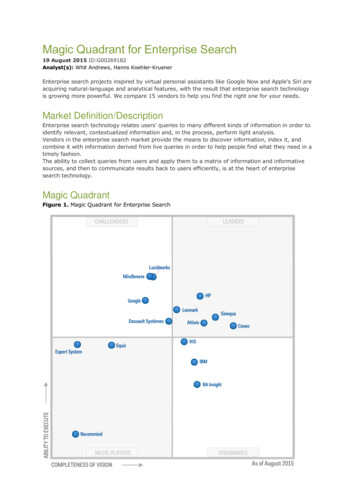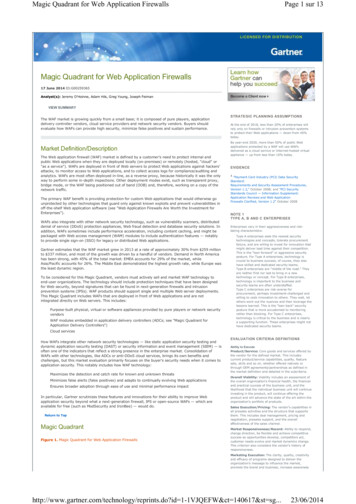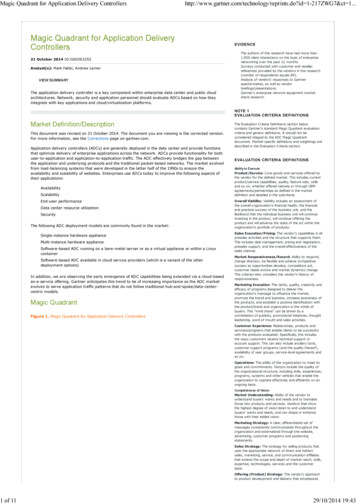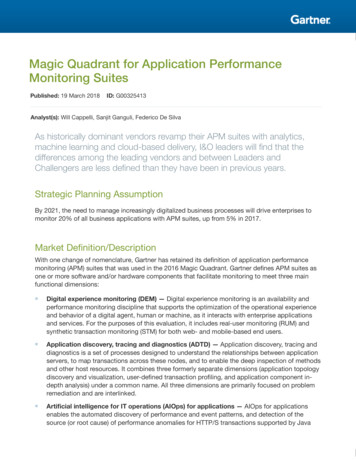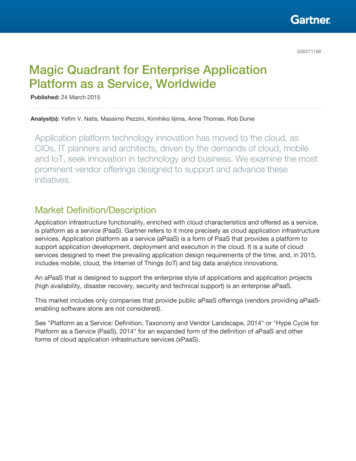
Transcription
G00271188Magic Quadrant for Enterprise ApplicationPlatform as a Service, WorldwidePublished: 24 March 2015Analyst(s): Yefim V. Natis, Massimo Pezzini, Kimihiko Iijima, Anne Thomas, Rob DunieApplication platform technology innovation has moved to the cloud, asCIOs, IT planners and architects, driven by the demands of cloud, mobileand IoT, seek innovation in technology and business. We examine the mostprominent vendor offerings designed to support and advance theseinitiatives.Market Definition/DescriptionApplication infrastructure functionality, enriched with cloud characteristics and offered as a service,is platform as a service (PaaS). Gartner refers to it more precisely as cloud application infrastructureservices. Application platform as a service (aPaaS) is a form of PaaS that provides a platform tosupport application development, deployment and execution in the cloud. It is a suite of cloudservices designed to meet the prevailing application design requirements of the time, and, in 2015,includes mobile, cloud, the Internet of Things (IoT) and big data analytics innovations.An aPaaS that is designed to support the enterprise style of applications and application projects(high availability, disaster recovery, security and technical support) is an enterprise aPaaS.This market includes only companies that provide public aPaaS offerings (vendors providing aPaaSenabling software alone are not considered).See "Platform as a Service: Definition, Taxonomy and Vendor Landscape, 2014" or "Hype Cycle forPlatform as a Service (PaaS), 2014" for an expanded form of the definition of aPaaS and otherforms of cloud application infrastructure services (xPaaS).
Magic QuadrantFigure 1. Magic Quadrant for Enterprise Application Platform as a Service, WorldwideSource: Gartner (March 2015)Vendor Strengths and CautionscloudControlcloudControl is a European vendor that provides a high-control, multilanguage, shared-OS aPaaSdeployed on Amazon Web Services (AWS) data centers. In August 2014, cloudControl added to itsPage 2 of 45Gartner, Inc. G00271188
geographic coverage and doubled its customers when it bought the dotCloud North AmericanaPaaS business from Docker. The underlying technology of the dotCloud aPaaS is being shifted tothe technology used by the cloudControl aPaaS instances (applications built for dotCloud have tobe migrated by May 2015), but the U.S.-based aPaaS will continue to operate under the dotCloudname, running on Google Compute Engine and offering an alternative infrastructure to the AWSbased cloudControl branded PaaS. The vendor also offers a white-label aPaaS program, mostly totelecommunications companies and infrastructure as a service (IaaS) providers, where cloudControlprovides its aPaaS as a managed layer on top of the partner's IaaS offering. Exoscale, inSwitzerland, is an example of a white-label partner.All of the U.S., European and white-label implementations provide the same developer and runtimeservices with the same APIs, the same levels of support, and the same pricing arrangements. Inaddition to its buildpack-based deployment model, cloudControl offers an add-on marketplacewhere users can leverage more than 40 third-party services in areas such as continuous integrationand deployment, log management, email, search, security, data management, analytics, andmessage queuing.Strengths The vendor has over 1,400 registered customer accounts with more than 800 activedeployments across its dotCloud and cloudControl branded services. Overall revenue fromaPaaS services has been growing through the dotCloud acquisition, the white-label programand organic growth. Support of the buildpack specification enables cloudControl, its partners and its customers toextend the platform with new language engines, frameworks, databases and other softwareservices available from other vendors that support buildpacks. The vendor provides andsupports many buildpacks, but developers can create their own to expand the technologies thatthey can use. The vendor's white-label aPaaS program offering for telecommunications companies and IaaSproviders provides a potentially powerful mechanism for expanding geographical coverage byacting as a force multiplier for cloudControl sales and marketing.Cautions cloudControl's use of the dotCloud brand in North America and its use of a white-label programfor expansion into other geographies limit the vendor's ability to grow worldwide recognition ofthe cloudControl brand. As a smaller competitor in the aPaaS market, this could create achallenge to cloudControl's long-term market positioning. Its use of so many add-on partners for advanced capabilities increases cloudControl's externaldependencies, and revenue sharing with these partners reduces cloudControl's net revenue. Slow growth of an ecosystem of SaaS providers that have built their applications oncloudControl's platform may be a handicap inasmuch as the extension and customization ofGartner, Inc. G00271188Page 3 of 45
SaaS applications are major drivers of aPaaS adoption in mainstream enterprise ITorganizations. Without high-productivity development services for application development and integration,business process management (BPM), and event processing, cloudControl revenueopportunities will be limited to a subset of the market for enterprise PaaS services.Engine YardEngine Yard is a cloud-based, shared-hardware, high-control aPaaS that uses a dedicatedenvironment for each tenant. The platform supports a limited set of languages and frameworks:Originally focused just on Ruby on Rails, Engine Yard now also supports Java, Node.js and PHP.Each supported environment is a managed and curated infrastructure stack with a configurablecomposition.Founded in 2006, Engine Yard was a pioneer in the PaaS market. The platform caters toprofessional developers looking for a low-level platform that hides and automates systemadministration of an underlying IaaS. (The platform runs on, and Engine Yard resells, AWS, Azureand Verizon Terremark.) For an aPaaS, Engine Yard provides exceptionally deep control of theunderlying environment. In fact, the vendor now refers to the platform as a cloud applicationmanagement platform, rather than aPaaS, indicating a shift in focus from aPaaS to utilitarian serviceprovider. Applications run directly on the host infrastructure, and subscribers have full root accessto the virtual servers. For example, subscribers can define custom Chef recipes to configure theservers. The platform supports manual and scheduled scaling, but no dynamic autoscaling.Strengths Engine Yard has over 1,500 Web 2.0 and digital business clients. It provides a solid foundationfor DevOps and continuous delivery. It remains the leading aPaaS for Ruby on Railsdeployments. Customers cite Engine Yard's responsiveness, support and reliability as key strengths. The vendor's tenant environments have been shown to scale well, and its underlyinginfrastructure can be extensively customized, which allows for advanced technical control forcustomers that want it. Engine Yard's transparent pricing model clearly shows costs for the Engine Yard platformversus the underlying IaaS, and this model is more cost-effective for larger customers than theprevious model. Customers can now also deploy Engine Yard on their own IaaS environments.Cautions From a business perspective, Engine Yard stumbled in 2013 when it attempted to expand itsmarket to line of business (LOB) clients in traditional corporate accounts. 2014 was a year ofchange, and the board brought in a new executive team and restructured the company. Thevendor is now refocused on its core strength: the developer and DevOps community. As aresult, growth opportunities are limited.Page 4 of 45Gartner, Inc. G00271188
Engine Yard has limited cloud capabilities, particularly in elasticity and sharing. Its sharedhardware model and lack of dynamic autoscaling mean that it is best-suited for environmentsthat benefit most from manual and preplanned approaches to changing capacity. Engine Yard is primarily focused on alleviating subscribers' responsibilities for managing systeminfrastructure, but not to the point of relinquishing control of those system resources. Althoughthe abstraction level provided does qualify as PaaS, much of the design and many of the usecases for Engine Yard are close to what Gartner calls "IaaS ." The vendor does not provide its own integration, BPM, big data and analytics capabilities, nordoes it offer a model-driven, high-productivity cloud platform environment. Those looking for anapplication platform for LOB levels of productivity or advanced enterprise projects should lookelsewhere.GoogleGoogle's aPaaS offering is available in the form of Google App Engine (a shared-OS, high-controlapplication platform) and managed virtual machines (VMs) — a somewhat extended technology ofApp Engine offered in the less restrictive, but also less elastic, shared-hardware format. Google'saPaaS offering supports Java, Python, Go and PHP programming. It is offered colocated withmultiple related services, including Google Compute Engine and future Google Container Engine(both IaaS), as well as some xPaaS offerings, such as SQL and NoSQL database managementsystems (DBMSs), analytics and mobile back-end services.Strengths Google's large installed base (it claims over 20,000 paying customers) consists of many smallWeb innovators, some very large Web business sites (such as Snapchat and Khan Academy)and a small, but growing number of mainstream enterprise IT organizations. Additionally,Google claims that over 90% of its internal IT is run on App Engine. This diversity in scale anduse patterns creates a strong foundation for support of demanding enterprise workloads thatalso differ in use patterns and demand for quality of service across industries. Google's well-established reputation as a cloud-native service provider and an early platformand big data innovator lends credibility to App Engine and other xPaaS offerings for projectsthat seek cloud-native efficiency, scalability and agility. Google's aPaaS offering operates onthe same worldwide network of data centers as all other Google services, such as GoogleSearch and Google Apps for Work, reassuring its strategic priority to the company. Some of Google's recently added enterprise capabilities (including 99.95% availability SLAs;multiple models for disaster recovery; enterprise-level support, a relational DBMS in addition tohigh-scale NoSQL; nonintrusive version control; no planned downtime experience forcustomers; dynamic multimeasure bidirectional autoscaling; application life cycle management;API management; rich security support; cost optimization for workloads of different urgency;event processing; and conversational mode via channels) mitigate the long-standing obstaclesto enterprise adoption of Google's aPaaS.Gartner, Inc. G00271188Page 5 of 45
API-level integration with Google Apps enables the vendor to offer its PaaS capabilities as anupsell to enterprises adopting Google Apps and looking for new ways to extend them usingadvanced programming. The combined selling of Google Apps (SaaS) and Google CloudPlatform (IaaS and PaaS) is a promising business opportunity.Cautions Google's historically limited reputation as an enterprise service provider, in general, and itssmall presence as an enterprise PaaS provider, in particular, have created a perception that it isa consumer-only vendor. To succeed as an enterprise platform provider, Google must developan aggressive and convincing marketing campaign to overcome this perception. Beyondmarketing, Google will have to continue to aggressively develop sales and accountmanagement practices to match the traditional expectations of mainstream enterprise IT (e.g.,continuity, presence and trust). The lack of a model-driven, high-productivity aPaaS option in the Google Cloud Platformportfolio limits the addressable market for Google's aPaaS offering to highly skilled developers.Most enterprise LOB IT and citizen developers, and some productivity-oriented central ITapplication projects, will find that App Engine does not match well with their productivityrequirements and skill sets, keeping Google out of the fast-growing Mode 2 cloud platformmarket in bimodal enterprise IT. A strategic focus on public cloud-only services and the absence of on-premises versions ofGoogle software exclude the vendor from consideration by some more conservativemainstream enterprises looking for a hybrid PaaS environment as a kind of risk controlapproach. The few third-party attempts at porting App Engine to on-premises (for example, RedHat CapeDwarf and AppScale) lack assured viability and have not gathered a substantialfollowing, despite Google's cooperation and endorsement. Google's portfolio of xPaaS capabilities misses some important services typically used byenterprise customers in conjunction with aPaaS. These especially include application and dataintegration, advanced in-memory computing, BPM, and legacy migration services. This delayedrecognition of larger enterprise requirements puts Google at a competitive disadvantage in themainstream enterprise computing market.IBMIBM's aPaaS offering is part of its Bluemix suite of PaaS capabilities (xPaaS), developed andsupported by IBM, its partners or the open community. These include database, integration, mobile,DevOps, security, monitoring and other services. IBM Bluemix is deployed on the network ofSoftLayer data centers worldwide. IBM Bluemix is based in part on the open-source OpenStack andCloud Foundry v.2 software.The Bluemix Liberty for Java offering implements IBM WebSphere Application Server Liberty Coreas a Cloud Foundry buildpack. Managed by the Cloud Foundry PaaS framework using its WardenOS container, it is a shared-OS, high-control, cloud-based application platform service. IBM alsoprovides the SDK for Node.js aPaaS environment. Other language environments and fr
Magic Quadrant for Enterprise Application Platform as a Service, Worldwide Published: 24 March 2015 Analyst(s): Yefim V. Natis, Massimo Pezzini, Kimihiko Iijima, Anne Thomas, Rob Dunie Application platform technology innovation has moved to the cloud, as CIOs, IT planners and architects, driven by the demands of cloud, mobile and IoT, seek innovation in technology and business. We examine the .

